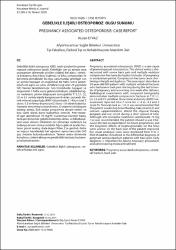GEBELİKLE İLİŞKİLİ OSTEOPOROZ: OLGU SUNUMU
Özet
Gebelikle ilişkili osteoporoz (GİO), nadir görülen bir premenapozal osteoporoz tipidir. Gebeliğin son üç ayında veya postpartum dönemde görülen şiddetli bel ağrısı, vertebra kırıklarına ikincil boy kısalması ve kifoz semptomları ile karşımıza çıkmaktadır. Bu olgu sunumunda, gebeliğin son üç ayında başlayan ve doğumdan bir hafta sonra şiddetlenen sırt ağrısı ve çoklu vertebral kırığı olan 29 yaşındaki GİO hastası tanımlanmıştır. Son trimesterde başlayan ve doğumdan 1 hafta sonra giderek kötüleşen şiddetli bel ağrısı nedeniyle çekilen bilgisayarlı tomografide T12, L1, L2, L3 ve L5 vertebralarda kompresyon kırıkları saptandı. Kemik mineral yoğunluğu (KMY) ölçümünde; L1-4 için total Z skoru -3.3 ve femur boynu için Z skoru -1.6 olarak bulundu. Hastanın emzirmeyi sonlandırması, D vitamini ve kalsiyum desteği alması, fizik tedavi programına devam etmesi ve kısa süreli olarak korse kullanması önerildi. Anti-rezorptif ajan (alendronat 70 mg/hf) kullanması önerilen hasta, ilerleyen dönemde gebelik beklentisi olması ve bifosfonatların uzun dönem etkilerinin net olmaması nedeniyle bu tedaviye devam etmeyi reddetti. Ağrısı giderek azalan hastanın görsel analog skala değeri 9’dan 2’ye geriledi. Gebe ve loğusa hastalardaki bel ağrısının ayırıcı tanısında GİO göz önünde bulundurulmalıdır. Tanının erken dönemde konulması, önlem almayı ve gerekli tıbbi tedaviyi başlamayı kolaylaştıracaktır. Pregnancy associated osteoporosis (PAO) is a rare cause of premenopausal osteoporosis. This clinical entity is characterized with severe back pain and multiple vertebral compression fractures during last trimester of pregnancy or postpartum period. Compression fractures cause shortening in heigth and kyphosis. This case report describes a 29-year-old GIO patient with multiple vertebral fractures who had severe back pain starting during the last trimester of pregnancy and worsening one week after delivery. Radiological examination with computed tomography demonstrated multiple compression fractures in T12, L1, L2, L3 and L5 vertebras. Bone mineral density (BMD) measurement reported total Z score for L1-4 as -3.3 and Z score for femoral neck as -1.6. It was recommended that the patient would stop breastfeeding, take vitamin D and calcium supplementation, attend the physical therapy program and use corset during a short period of time. Although anti-resorptive treatment (alendronate 70 mg / w) was recommended, the patient refused to use it because she had an expectation for future pregnancies and the long-term e?ects of bisphosphonates on the fetus were unclear. As the back pain of the patient improved, her visual analogue scale value decreased from 9 to 2. PAO should be considered in the di?erential diagnosis of pregnant and postpartum patients with back pain. Early diagnosis is important for taking necessary precautions and administering medical treatment.
















